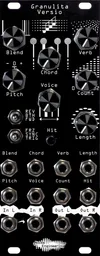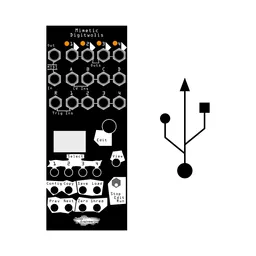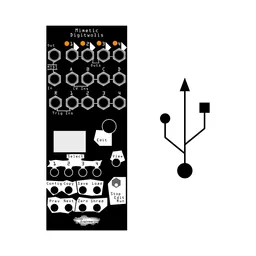
Arturia makes a very cool little keyboard called the MicroFreak. We think it’s pretty nifty. So nifty that as of today, you can get three Noise Engineering oscillators for it!
Noise Engineering firmware for the MicroFreak?
Yes. You read that correctly.
Microwhat?
MicroFreak, by Arturia. It’s a very cool little hybrid synth. It does a TON and is super fun and performative. It has a CV and Gate output, and clock and MIDI in and out, so there are lots of ways to make it work with your Eurorack setup. It can play up to four voices for some cool paraphony. The modulation matrix is awesome and allows you to route five sources to seven destinations. And best of all, it’s all controlled by a, yes, nifty touch keyboard for lots of expressiveness and futuristic piano magic. In short, it’s powerful stuff in a tiny package.
Tell me more.
Today we are excited to tell you about three oscillators we developed for the MicroFreak. And they are available as a free download for your MicroFreak. Free? Yes, free, our favorite four-letter f-word. The oscillators are called Bass, SawX, and Harm. What do they do, though? Read on, young padawan, for a bit about each algorithm and what the knobs do in each.
Bass
There exists an extremely esoteric and cool series of writings called Electronotes by the amazing Bernie Hutchins, retired professor of Electrical Engineering at Cornell University. Electronotes has a kind of cult following and is extremely hard to find. There was a time where you could send Dr. Hutchins some money and in return you would get boxes and boxes of loose paper: all of the Electronotes published, just printed out. Notes in these include real gems by all sorts of names you know if you’re into synthesis.

Electronotes #73 includes reference to an algorithm called Bass (we assume pronounced like the fish, as it is named after a person, not the clef). It's a simple algorithm that uses nonlinearities combined with quadrature modulation to produce a variety of tones. The Bass oscillator, as you may have guessed, is based off of this algorithm. Of course, we added a few Noise Engineering touches (fold anyone?) for more edgy sounds.
In Bass mode, the knobs become Saturate, Fold, and Noise.
Saturate controls the saturation of the cos oscillator (see the figure above).
Fold controls a two-stage asymmetric wavefolder.
Noise is phase mod of both oscillators (opposite phase) and added between fold stages; the knob controls the level of noise added.
You read that right: you have parameters for distortion, more distortion, and noisy-modulatey-wonderfulness. We’re living up to our name with this one!
SawX
If you are reading this, chances are good that you know that we make a module called Manis Iteritas.The SawX algorithm draws from some of the techniques that we used there. The core is a simple super-saw oscillator with the saw-mod technique similar to what is in Manis Iteritas, but for a lot of reasons, it sounds quite different. It’s still full of sawtooth goodness, it’s just different sawtooth goodness.

In SawX mode, the knobs become Saw Mod, Shape, and Noise.
SawMod controls the gain into a modulus stage.
Shape determines the amount of chorus added to the oscillator.
Noise sets the amount of phase modulation by subsampled white noise.
Harm
For the Harm algorithm, we again capitalized on some existing techniques we have in our stable. The basic oscillator is a sinusoidal additive synth -- similar to Basimilus. But again, there are many ways to make an additive synth, and Harm mode sounds quite different from the BIA. The concept only served as the baseline. We tweaked a bit and then added a slight distortion stage: this time, a digital implementation of something similar to our analog distortion Pura Ruina.
In Harm mode, the knobs control Spread, Rectification, and, you guessed it, Noise.
Spread adjusts the relationship between the partials. At zero it is unison, at max it is octaves. The middle interpolates linearly in frequency.
Rectification allows an adjustable rectification of the individual partials. Think of this as sort of like a half fold.
Noise in Harm mode controls the amount of phase-modulated noise and master clip level.
There’s a lot of technical mumbo-jumbo in all of these, but if you’re not into the geeky side of things, don’t worry: all of this basically translates to “cool knobs make cool sounds”.
Extremely astute readers may recognize the names of these oscillators. Read on.
I want to hear! I want to hear!
You’re in luck. Take a listen:
How did this happen?
A couple of years ago at NAMM, we got to chatting with the fine folks at Arturia. They showed us the then-new MicroFreak and were excited about the idea of bringing new sounds to it. They suggested they would be interested in us developing two different algorithms. We were interested.
But then things got busy. We had a lot going on in 2019. Arturia did too. Things got in the way. We made some progress, but we could never quite get it all together to release. And having never developed on their platform, we were not fully sure what could be implemented, so to hedge our bets, we came up with three oscillators.
When we finally met up at NAMM 2020 we were ready to make progress! At that point, we had also been developing the Virt Iter, which seemed like a reasonable fit for these same three algorithms. Arturia was fabulous -- rather than being territorial, they were excited about the prospect of us using the same algorithms in our product as well as theirs. We started working on a contract... which promptly got lost in the mail in the midst of global shutdowns. Which was probably okay since no one was in the office at Arturia anyway since Covid-19 locked down France. While we were sorting out that debacle, Arturia came back and said hey, so... we like all three oscillators you sent. What do you think about us using all of them? So the contract delay worked out reasonably well in the end.
What about the Virt Iter then?
Virt Iter, like Versio, is meant to be a platform, so when we release it, we’ll also be making other firmwares for it. It’s like getting a lot of modules for the price of one! We showed the Virt Iter at NAMM 2020 with the three algorithms we developed for Arturia, with one difference: MicroFreak has three parameter controls, and Virt Iter has only two. For the MicroFreak, we added a Noise parameter to each mode. It behaves slightly differently in each mode, but it’s probably enough to say here that it’s a good way to increase the grittiness of the sound. So even though the core is the same, you’ll be able to get some different sounds out of each product.
Shortly after NAMM, we realized that a minor bug on the hardware meant a full hardware revision needed to happen. In 2020, that was not a small thing. With a lot happening, Virt slowly moved down the priority list. But we’re happy to say that what we THINK is a final hardware prototype is in process, and 2021 will be the year of Virt Iter. We think. But you know what, if we’ve learned anything in the past 12 months, it is that anything can happen.
How do I get the soundz?
MicroFreak’s new oscillator algorithms are the result of a different kind of journey in a different kind of year.
If you already have a MicroFreak, then you can go grab the free (hey there’s that word again!) download here. If you don’t, and you have been eyeballing a MicroFreak, here’s another reason to grab one.
How do I hear more?
By checking out the immensely cool video below by our pal Tom Hall, of course, or go to the Arturia page for some more sound examples!






